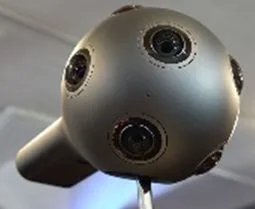Conceived at the company’s R&D facilities in Tampere, Finland, Nokia introduced Ozo at a recent event in Los Angeles attended by representatives from major studios, production houses and media and technology companies. OZO is billed as the first commercially available virtual reality camera designed and built for professional content creators. This product is the first in a planned portfolio of digital media solutions from Nokia Technologies (Sunnyvale, CA), the company’s advanced technology and licensing business. It is planned that the Ozo will be manufactured in Finland.
The Ozo can capture audio and video from 360 degrees around the camera. It is physically a sphere about the size of a large cantaloupe. The camera weighs about 6 pounds (2.7Kg). A standard SDI and power cable can be used with the camera while on set, but Ozo can also be operated wirelessly using an internal SSD and battery, while being controlled remotely via Wi-Fi.
Ozo includes eight optical image sensors spaced roughly an eye width apart.
Audio is captured in three dimensions by eight microphones embedded in the camera. When played back, Nokia’s audio rendering technology recreates binaural audio based on the direction of the user’s gaze. The result is audio that helps locate the user in space.
The camera is made to mount on standard professional camera tripods.
Nokia intends that the Ozo camera, which is now in its preproduction phase, be used by studios, the media and the advertising industry for recording virtual reality experiences. Clearly, the Ozo is not a consumer product in that it is expected to sell for a price in the mid-five figures of dollars.
In terms of its’ target customer base, Ozo has a number of selling points. The camera allows recording VR in real time. Two features make this possible. The first is that the Ozo camera allows viewing the 3D video in real-time. Directors can wear a headset and monitor 3D video as it is recorded. The second is rapid playback. In the past, VR video needed to be digitally stitched together before it could be viewed, a process that could take hours. Ozo’s playback system can render lower-resolution video for playback in as little as a few minutes thus removing the need to pre-assemble a panoramic image.
It might be mentioned that early on-line commentary on the prototype system reported “discontinuities” in the image. Nokia head of research and development, Vesa Rantanen, explained that these can be eliminated in post-production.
Nokia states that “The goal was to make a system that would integrate into filmmakers’ existing workflows, and not to trap them in proprietary file formats.” The camera also works with third-party tools, dramatically simplifying content production at all stages.
Ozo content can be published as 3D video on a site like YouTube. It can be viewed using commercially available VR viewing hardware such as head mounted displays of which the Oculus headset is one example.
In related news, VR production company Jaunt Inc. (Palo Alto, CA) has agreed to be one of Nokia’s first partners for the new camera. Jaunt has announced plans to make the camera available for use at the company’s studios and by offering post-production services to content captured by the Ozo camera.
Nokia is planning to conduct final testing and refinements to Ozo in partnership with industry professionals, in advance of the product’s commercial release. Final pricing and full technical specifications will be announced at a formal launch on an unspecified future date, with shipments anticipated in Q4 2015. -Arthur Berman
Nokia Technologies, 408-203-5906, [email protected]

